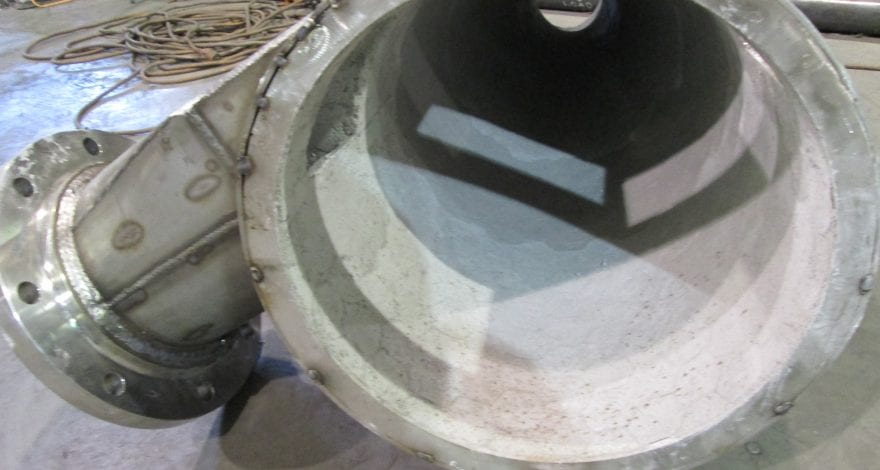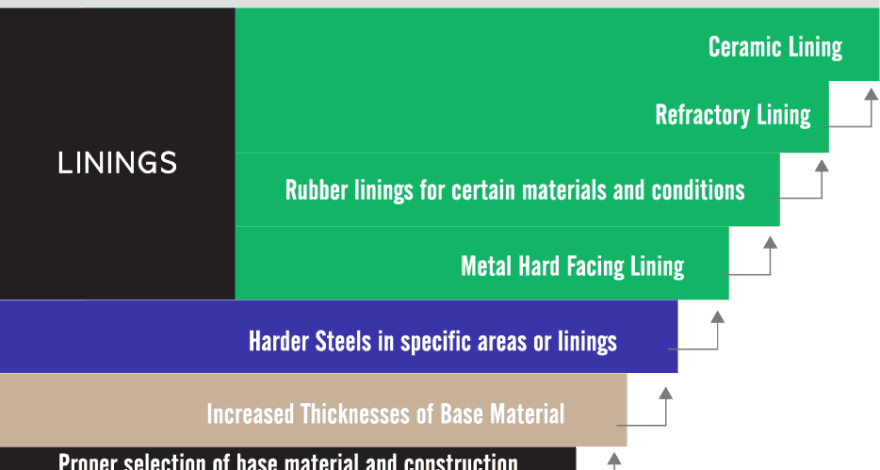Cyclones separate particles from a flow stream by moving them towards the walls of the cyclone via centrifugal motion. Internally, these acceleration forces can reach several hundred times that of gravity. However, many types of particulate are highly abrasive to the metals that are commonly used to build cyclones. In these cases, there is something of a hierarchy of solutions which can extend the equipment’s lifespan if it is determined that the rate of erosion is too great. As a rule, the hierarchy of solutions can generally be arranged in order of lower equipment cost and shorter life, to longer life and greater equipment cost.
What is a refractory?
ASTM C71 defines refractories as “…non-metallic materials having those chemical and physical properties that make them applicable for structures, or as components of systems, that can be exposed to harsh environments above 1,000 °F (811 K; 538 °C).”(1)
As it pertains to cyclones, a refractory refers to the type of material used to line the interior of high efficiency cyclones. The materials used to make refractories are resistant to the effects of heat, pressure, physical, and/or chemical attack. They usually retain their strength and form at high temperatures, making them an optimal choice when dealing with highly abrasive materials in a cyclone. (2)
Applying a refractory lining to a cyclone
Although the range of materials and bonding mechanisms for refractories is quite extensive and complex, for simplicity’s sake, think of a refractory like common cement. It starts in a dry granular form then is mixed with other components (often water). When this happens, it begins to transform in structure and phase, eventually bonding into a hard material. Because it starts in the liquid phase, it can be pumped, poured, troweled, or sprayed into place where it can harden into a desired shape.
The internal surfaces of a cyclone consist of flat surfaces (e.g. cyclone roof and inlet floor and roof) and vertically oriented cylindrical and conical shapes. The methods used to anchor the lining to the shell surface are critical to the quality of the lining and its subsequent performance.
Refractory linings can be applied in various thicknesses from a minimum of about ¾” -18” (19mm- 457mm). If the refractory lining is intended for erosion protection, it will typically be relatively thin and composed of very hard composite materials that have specialized chemical bonding properties. This can result in exceptionally hard linings. The test? Hit it with a hammer! When properly installed and dried, these linings should not chip when struck with a hammer.
HEC lines cyclones for various severe duty services where the particulate is quite abrasive. Some common examples of industrial processes we’ve built refractory lined cyclones for are:
-
- Fluid bed reactors and combustors (e.g. Petroleum refining using the FCC process, Acrylonitrile, Catoxid, Oxychlorination [OHCl], Propane Dehydrogenation [PDH], Methanol to Olefins [MTO], etc.)
- Sand cooling and drying
- Coal and wood fired boilers
- Forest products [since the handling and processing of timber introduces soil, sand, and minerals with the wood.]
While refractory linings have been around for a very long time, advances in their composition, quality control and installation procedures have resulted in great increases in their reliability and service life. Heumann Environmental is experienced in providing these linings in our cyclones in the manner that provide the highest quality refractory linings at the lowest possible cost. This is a result of not only our experience and knowledge in the field but in our manufacturing flexibility and capabilities that allow for us to stage the sequence of fabrication and refractory lining so that the highest standards are always maintained.
- ASTM Volume 15.01 Refractories; Activated Carbon, Advanced Ceramics
- Ailsa Allaby and Michael Allaby (1996). Concise Dictionary of Earth Sciences. Oxford Paperbacks Oxford University Press.

